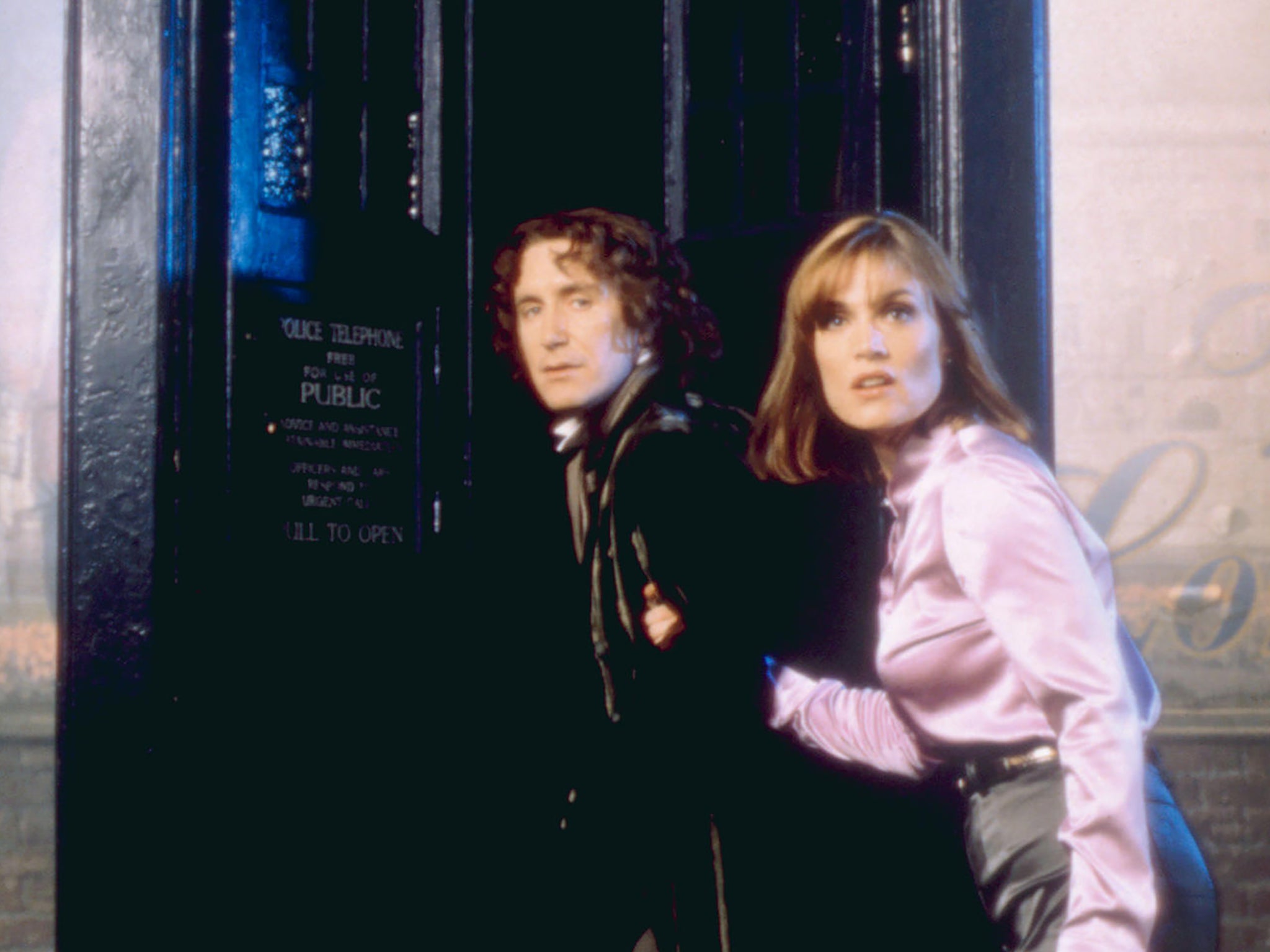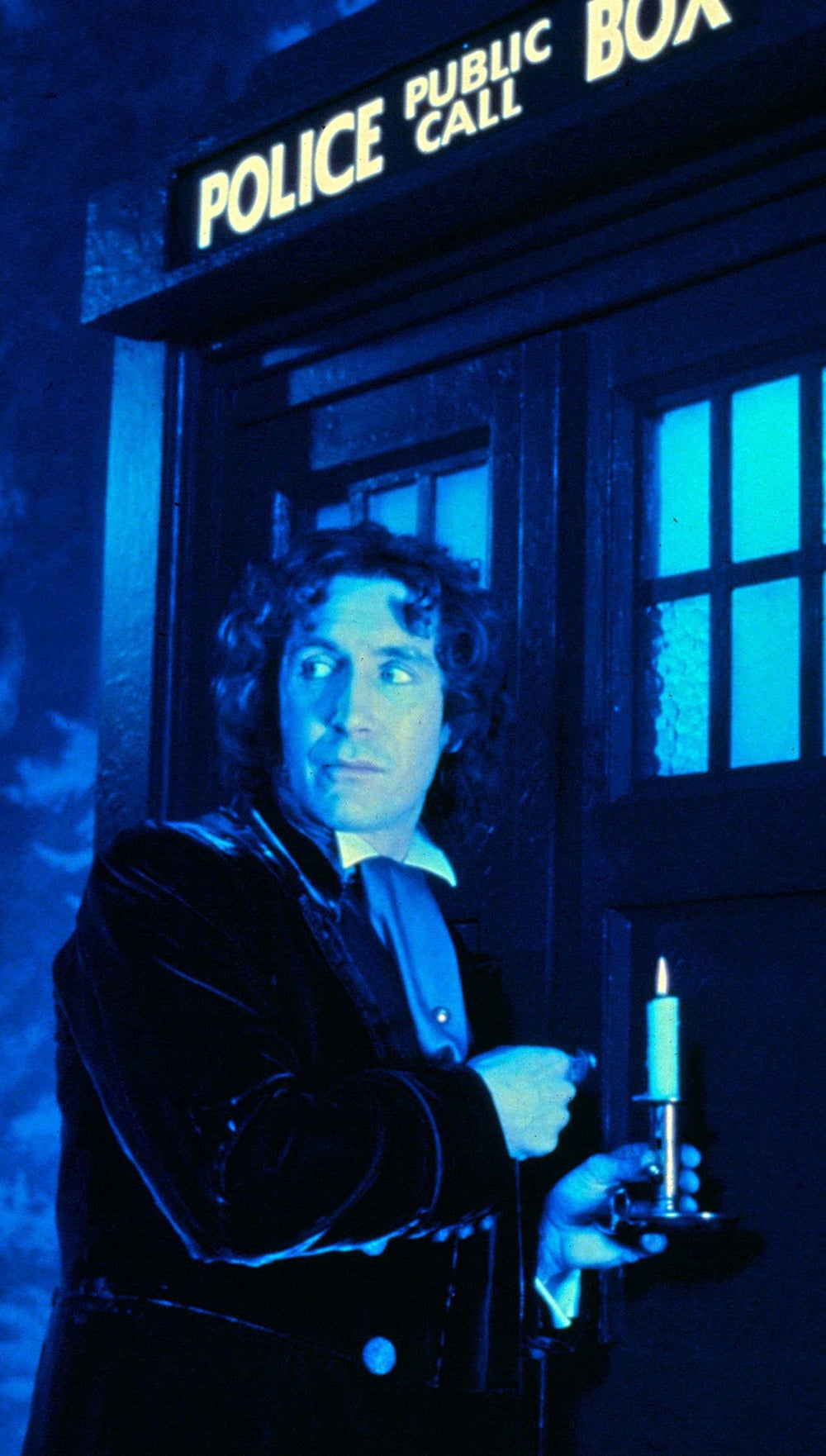Red, white and Who: Was the American reboot of Doctor Who really that bad?
Dubbed ‘a numbing disappointment’ upon release, the 1996 ‘Doctor Who’ movie starred Paul McGann, was set in San Francisco, and attempted to breathe life into the then-dormant sci-fi series. As the film turns 25, Clémence Michallon explores what went wrong, and speaks to the fans eager to see it reappraised


Your support helps us to tell the story
From reproductive rights to climate change to Big Tech, The Independent is on the ground when the story is developing. Whether it's investigating the financials of Elon Musk's pro-Trump PAC or producing our latest documentary, 'The A Word', which shines a light on the American women fighting for reproductive rights, we know how important it is to parse out the facts from the messaging.
At such a critical moment in US history, we need reporters on the ground. Your donation allows us to keep sending journalists to speak to both sides of the story.
The Independent is trusted by Americans across the entire political spectrum. And unlike many other quality news outlets, we choose not to lock Americans out of our reporting and analysis with paywalls. We believe quality journalism should be available to everyone, paid for by those who can afford it.
Your support makes all the difference.Doctor Who: The Movie wasn’t the fiasco you remember. The 89-minute TV special, first broadcast in 1996, was meant to serve as the first episode of a planned revival of the sci-fi hit, with Paul McGann starring as the Time Lord. Doctor Who’s original run had ended in 1989 after 26 years, but a British-American TV producer named Philip Segal had long mulled over rebooting the show as a transatlantic collaboration.
On paper, the TV movie failed. Set in San Francisco rather than contemporary England, yet filmed in Vancouver, it retains old-Who’s dubious special effects but is otherwise strictly Nineties: there are shoot-outs in alleys, underworld gangs and a villain in cool shades. “A numbing disappointment,” according to the Radio Times, it also earned dreadful ratings in the US. As a result, Doctor Who stayed buried for another nine years, and to this day, McGann remains the actor with the shortest run as the Doctor.
But, as the film turns 25, there’s a growing consensus that it wasn’t the unmitigated disaster it’s sometimes made out to be. There have been mounting efforts to rehabilitate it in the collective mind, with think pieces revisiting its legacy and fans readily singing its praises.
“It’s something I’ve always looked at fondly,” says Rik Moran, a publications manager at the Doctor Who Appreciation Society, the longest-running Who fan club. “There was great potential if it had been picked up as a pilot for a series. ... If I am to watch any piece of Nineties TV, it stands to the quality of other TV shows that were out at the time. It looks no different to me than an episode of The X-Files.”
That it looked like a lost X-Files episode and not Doctor Who may have been one of the film’s issues. Viewed in 2021, Doctor Who: The Movie was fine, if imperfect – its few shortcomings just made it ill-suited to the mission it was supposed to fulfill.
Plot-wise, it holds up. The Doctor (portrayed by Sylvester McCoy in the opening minutes) is transported to San Francisco’s Chinatown, where he gets shot to death. In a wonderfully creepy sequence at the hospital morgue, he regenerates into the form of McGann, but the new incarnation suffers from amnesia. Meanwhile, his prolific alien nemesis the Master (Eric Roberts – yes, Julia’s brother) returns with evil plans in mind. So far, so Galiffrean. But the problems began as soon as the film was set to air in the US on 14 May 1996.
That date may not ring a bell on its own, but consult old TV listings and you’ll see that Doctor Who: The Movie aired at the same time as the penultimate episode of the eighth season of Roseanne. In 1996, Roseanne was not only one of the most popular sitcoms in the US, but one of the country’s most popular TV programmes. An Entertainment Weekly analysis puts it on par with such ratings monsters as ER, Seinfeld, and a little show known as Friends. This particular Roseanne episode drew 20.97 million viewers, compared to just 5.6 million for Doctor Who.
Fans knew the bell had tolled: “We saw the American ratings and went, ‘It’s over, it’s not going to happen,’” says Moran.

As disappointing as it may have been for devotees, American audiences’ lack of interest for the film back then is hardly surprising. Picture yourself as an American in the mid-Nineties. The internet isn’t high-speed yet, meaning Tumblr culture isn’t a thing. You haven’t been exposed to memes or gifs about Doctor Who. (The BBC struck a deal to distribute Doctor Who on US television in the Seventies, but it was far from a prime-time behemoth.) Chances are you’ve never even heard of Doctor Who, or you might just be vaguely aware of it as a kooky British import. On a Tuesday night, when you’re tired and looking for some reliable entertainment, are you going to tune into a tried-and-tested sitcom like Roseanne, or a quirky TV special set in an elaborate fictional universe you know nothing about? I’ll be the first to admit that in this situation, I’d go with the former.

Watch Apple TV+ free for 7 days
New subscribers only. £8.99/mo. after free trial. Plan auto-renews until cancelled

Watch Apple TV+ free for 7 days
New subscribers only. £8.99/mo. after free trial. Plan auto-renews until cancelled
But some people did tune in. Not many, but some. And what did they see? Basically a long, solid Doctor Who episode with a new lead and a budget of $5m – an astronomical sum for the franchise. In the late Eighties, “the stories were there”, Moran recalls, but producers “didn’t always have the money” to bring them to life effectively. But while a budget boost sounds great in theory, it ultimately played against the film’s best interests.
Doctor Who is famous for its low-cost aesthetic. Far from ruining the programme, it’s part of its appeal. The show has a tongue-in-cheek quality, like it’s aware of its own eccentricities and invites you to revel in them. The sleek finish of the 1996 film renders it too serious, bordering on stiff. As a show, Doctor Who is… well, a lot. There’s plenty of backstory, catchphrases, concepts, and characters – all of which are much harder to stomach in this high-octane version.
Journalist Kim Newman, who wrote about the film for The Independent upon its release, noted that “a great deal of British popular television can only benefit from the vigour of the American approach”, but that Doctor Who, in this instance, was “really hurt” by such an influx of cash. Twenty-five years later, he stands by that assessment. “I think the production’s expense – very middling in US film and TV terms – worked to sandpaper off some of the eccentricities that make the show work at its best,” he says. “One lesson Russell T Davies [one of the architects behind the 2005 reboot] evidently learned was to approximate the production values of US TV but root the show in Britain.”
None of this should be taken as an indictment on McGann’s performance, though. He was brilliant as the Eighth Doctor, infusing the role with the perfect mix of naivety and looming melancholy. It’s a shame we never got to see more of him as the Time Lord. “Paul McGann may well be the best actor ever cast as [the Doctor],” Newman wrote in 1996. “He is the miraculous survivor of a production that otherwise consistently doesn’t quite work.” In fact, Newman now views McGann’s performance as a precursor to the Doctors we’ve seen in the ongoing reboot, from actors such as Christopher Eccleston, Matt Smith and Jodie Whitaker. “It’s evident that McGann fits into the way the role has been cast since 2005, going to an established or just-about-to-break leading man,” he says. “Or, now, woman.”
The “new Who” succeeded where the 1996 film failed. Not only is the show still going strong, but it has generated multiple new generations of fans, including – yes – on the other side of the Atlantic. Interestingly, it has wooed Americans precisely by trying less hard to pander to them – it is firmly rooted in its British origins, with a nicely understated production, outfits at the intersection of wacky and dapper, and the cast and filming locations doing the rest. But it’s also worth remembering that the 2005 version wasn’t immediately a runaway success. Christopher Eccleston, the first actor cast as the revival’s protagonist, had the second shortest run in the series, starring for just one season. I lived in France in the mid-to-late 2000s, and it wasn’t until David Tennant was firmly established as the Doctor that the show began catching the attention of international audiences. Things reached their full swing with the Matt Smith era, which began in 2010 – a good five years into Who’s resurrection.
One thing the 2005 reboot always had going for it, however, was a strong sense of tone and aesthetics. Yes, some elements shifted along the way, but the series knew what it set out to do from the offset: to elicit a sense of childlike wonder from viewers, and to play off the Doctor’s eccentric coolness.
With a production that didn’t quite know what it wanted to be, Doctor Who: The Movie struggled to take flight. We now know that Americans were capable of loving the Doctor – many of them have for the past 16 years – but not then, and certainly not like that. Trust a time traveller to need a few goes to get things just right.



Join our commenting forum
Join thought-provoking conversations, follow other Independent readers and see their replies
Comments